![]()
![]()
We somehow obtained what may very well could have been the last sealed, unopened, complete Hirobo Falcon 505 kit in existence! Considering the limited numbers in which they were produced, and that the kit was then 28 years old, this was an incredible find! Here it is, with the March 31, 2008 USA Today for proof!
Reference photos for posterity of how the kit was originally packaged by the factory in 1980 (click each picture to enlarge)
It quickly became apparent that the Hirobo instructions were sorely lacking and contained quite a few errors. We found ourselves referring to the large scale mechanical drawing of the helicopter more than to the actual instruction manual.
For power, we located and purchased a perfect, new-in-box, never run, period correct vintage O.S. Max .40 FSR engine with the classic OS Max #743 muffler:
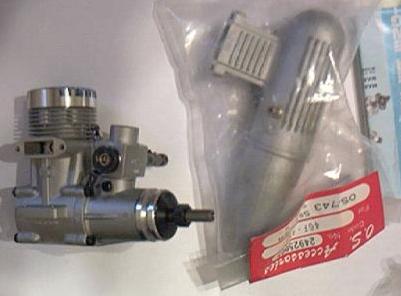
This was of course originally an R/C airplane engine, as they did not make helicopter-specific motors back in those days. What was normally done was to install and airplane engine and either use the specific Hirobo manufactured muffler made for the Falcon 505 / 707, or use a regular airplane muffler such as the OS Max #743 with a 90 degree angle exhaust adaptor so that the muffler points out to the back of the helicopter, rather than straight up or down, as would otherwise be the case:
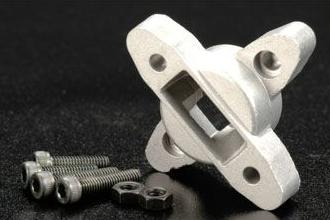
So far, so good. Next, we got to the point of installing the clutch. Here is where we made our first deviation from the a completely factory specified build. The 505's clutch is made of a black plastic or resin material:

It was reported to us through some old-time helicopter flyers that these clutches were notorious for burning up, and that they would typically last only around 20 flights or so. Upon inspection, we could easily see why. This clutch seems to be made from a relatively low-density plastic, and rotates inside a plain aluminum clutch bell with no friction material! One of our vintage helicopter friends reminisced about how he had hired a machinist to fabricate a metal version of this clutch for his 505 back in the 1980's. That got us to thinking.....
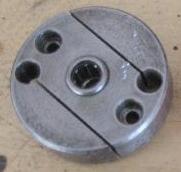
Very easy to do! We simply took an old GMP metal clutch, machined out the center hole to the proper diameter, and press-fit the stock 505 roller bearing assembly in the resulting hole. Next, we epoxied some clutch lining material into the inside of the 505's clutch bell, and bingo! Problem solved, and no visible changes to our Falcon! The metal GMP clutch fits the 505's flywheel perfectly (no surprise there I suppose)!
The next modification we made is another time-honored fix that's also both invisible and improves reliability. The supplied .062" diameter tail drive wire on the Hirobo and GMP helicopters is known to snap from stress, causing tail rotor loss. In building the 505, we did what countless helicopter modelers have done for decade before us: we drilled out both the front and rear tail drive couplers to .081" to accept a .078" diameter tail rotor drive wire (as we had in our Competitor project) and rather than using the stock brass tube and wooden drive wire spacers, we opted for a brand new set of vintage Tech Specialties TS107Z nylon spacers. Problem solved.
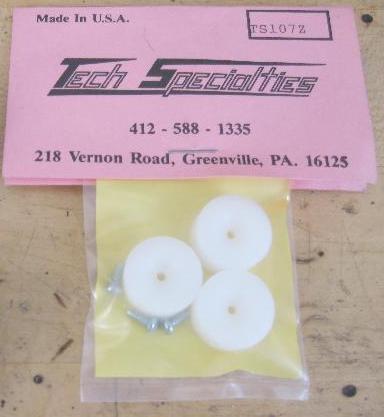
Our dipping into our Competitor
parts bin did not stop there. While on one hand, we are very concerned with
keeping this kit as original as possible, on the other hand, we are also
concerned about preservation, given the fact that we intend to fly this machine
on an ongoing (albeit infrequent) basis. Upon setting up the mechanical swash
mixer assembly, two things because apparent: (i) the main pivot bushings in
triangular plates supporting the collective arm had a very sloppy fit…we could
actually see the collective shaft wobbling back and forth inside the bushings!,
and (ii) many of the white plastic ball links that came with the kit were both
brittle and ill-fitting.
Problem #1 was quickly corrected by substituting the bushings with a set of
pivot ball bearings from the GMP parts bin. The bearings provided a much better
tolerance against the 505 collective shaft, and practically eliminated all play
on the pivot shaft.
Problem # 2 however was a really serious issue because should any of the ball
links fail or pop off in flight, we could almost be guaranteed of a crash, and
that is something that we want to avoid at all costs, because of a lack of spare
parts to rebuild this heli. One of our old-time helicopter friends remembers
that back in the day, everyone with a Hirobo Falcon he knew had to swap out
those ball links for something stronger. Out of necessity, we followed suit in
our build, and substituted all of the white Hirobo links for black rocket city
brand ball links that were supplied in the later GMP kits. There was actually an
early GMP Competitor bulletin urging all owners
with the earlier links to upgrade to the bigger rocket city links due to
multiple reports of the earlier links failing in flight.
The next issue became apparent once we started setting up the swash servo endpoints and travel adjustments. The primitive mechanical collective / cyclic mixer arrangement causes some strange swash interactions. At mid collective, we set the swash to level. So far, so good, however, when we raised the swash up to full collective, we noticed that the swash does not stay level as it should, but it tilts forward and to the left. Likewise, at full negative collective, the swash tilts rearward and to the right. This is not because the elevator or aileron servos are moving…they are not. It’s a problem inherent with having the elevator bellcrank offset to the left side of the frame, as the 505 was designed. We note that starting with the Falcon 707, a different elevator control mechanism was used that went around the main shaft, and thus tilted the swash from the helicopter's centerline, rather then from the left side, thus avoiding this strange swash interaction. Our solution was to program some custom electronic swash mixing (pitch > elevator, and pitch > aileron) into our DX7 transmitter to keep the swash level throughout its full collective travel, a feature we admit was likely not available to pilots in the 1980’s, but our doing so of course does not in any way alter the originality or appearance of the model.
We got through many of the other twists and turns involved in building this kit without much drama. There were a number of little issues that arose as things started to come together (take a look at that elevator control link for example).
We had always thought that GMP's solution of installing a hose clamp on the end of the tail boom to secure the cast collar for the tail gearbox was an "interesting" engineering decision. In light of what Hirobo recommended before that on the Falcons (namely, grind down the collar, and wrap around epoxy-saturated white thread), the hose clamp idea seemed a great solution!
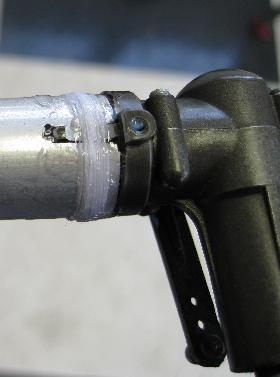
We set the collective travel to 8 degrees positive and 4 degrees negative. The 505's manual, as poorly written and incomplete as it was, seemed to suggest a max of 7 degrees positive and 2 degrees negative (while idling). We could have obtained a mechanical max of around 10 degrees positive according to our pitch gage, but we did not like the extreme angles of the bell / hiller mixer arms in the rotor head, so we decided to keep the max and min values near what was suggested on page 13 of the instruction manual. Since we were using 2 servos to control throttle and collective, it seemed as though we could deviate from this suggested setup and go with a more modern setup that started out a zero pitch at mid stick, then we could set a v-curve for our throttle curve to prevent overspeed at or near mid-stick, which otherwise would have been an issue using only one servo to control both throttle and collective. The ability to do this is yet another advantage of modern helicopter-specific radio gear, something only dreamed about back in 1980.
Speaking of radio gear, as we did with last year's GMP Competitor project, we opted for our standard radio system package comprising of a Spektrum DX7 radio, Futaba GY401 gyro with S9254 servo for the tail, and Futaba S9252 servos for the rest of the functions. Part of the reason for this is that we want to have a "fair" comparison of how this almost 30-year old helicopter flies against the modern designs of today, and against its later GMP derivatives, so it would only be fair to have the same quality gear (i.e. control response time, etc.) as available today. The other reason, quite frankly is again is safety and preservation of this model. Modern, spread-spectrum radio gear provides a much more robust control link than traditional, single frequency modulated R/C systems.

Hirobo Falcon 505 Build in Progress
After several weekends of free time, we were finally glad to announce that our Falcon 505 project was complete, and it was time to move on to flight testing and trimming!
Family Resemblance - the Falcon 505 and GMP Competitor
The first order of business was to break-in the engine a bit, get the blades tracked, and sort out any little issues we find once things get spinning, before we commit this model to the air!
Despite being extremely careful balancing and double-checking all rotating components, we got a bad vibration that would not go away. After some trial and error, we solved the problem by slotting the inner main blade mounting holes. That way, the main blades could pivot slightly and find their perfect alignment via centrifugal force, the way that every modern helicopter today does. The 505 was designed to have its blades fixed in position relative to the rotor head, in other words, non-articulating. Just a few mm of slotting of that inboard hole, and loosening up the inboard main blade mounting bolts slightly did the trick! Through trial and error, we set up a nice, smooth throttle curve to that yielded a pretty constant RPM throughout our collective pitch range. Due to the Falcon's lower gear ratio (smaller pinion but same main gear) as opposed to the later GMP models, the Falcon's headspeed RPM seemed to settle in at about 1,300 RPM, very slow by today's standards.
Airborne! The Brand-New, 28 Year Old Hirobo Falcon 505's first real flight!
Flight Report: Our very initial first flight impressions was that the Falcon 505 would be very similar to the Competitor in flight. We could feel that our powerplant (a .40 sized airplane engine) gave us only marginal flight power. Once tuned properly, however, the .40 does OK...not great, but OK. This helicopter could certainly use a .50, but we purposely wanted to built it as recommended by the manufacturer in 1980, and use a standard planker .40~.45 size engine, which we did.
Initial trimming and hovering were no problem. The CG was spot on, and we only needed very minor trim. About 76% gain on the GY-401 gyro which is a bit on the high side, but helps with the low tail rotor speed. Cyclic response felt ok just test hovering around. In this mode of flight, the helicopter was very stable and felt very much like a Competitor. However, in transitioning to forward flight, we were disappointed to see how little cyclic authority this helicopter really had. It remained very stable, and controllable, it just really did not want to go too far out of its way in any direction in response to cyclic inputs. We had taken great pains to completely maximize swash travel and set the most aggressive cyclic endpoints we could, but in the end, we really did not have enough authority to even try a basic loop or roll with this helicopter, so we flew around the field for a few circuits before coming in for a nice, smooth landing.
Both the Mk1/Mk2 and the 505's were sort of "autostable". When trimmed correctly, they would just sit there hovering and did not like to be disturbed. One of the main fundamental differences between the 505 and all later derivatives of the family line is that the 505 was the last to use the 8mm diameter main rotor shaft and the unique rotor head design that debuted (albeit with a somewhat different control rod linkage setup) in the original Falcon Mk1 (see pictures above). One of the really strange things about this design is that the Hiller paddles (which in the 505 are very heavy cast alloy pieces with hollow jet-engine looking tubes on the outside edges) actually go collective! In other words, when you increase collective pitch on the main blades, the paddles also increase pitch. They do not stay flat and in sync with each other they way they do on all modern designs, and indeed on all later Falcon and GMP helicopters. The 505 therefore, represented the end of the evolutionary line for this rotor head design.
Either because of its primitive rotor head design, or because of its incredibly heavy cast metal Hiller paddles, the Falcon 505 is so stable, that it's really a chore getting it to move in any cyclic direction. In this sense, it was probably a great beginner model for its day, because panicked cyclic inputs would not upset the model so much. On the other hand, we found this "feature" kind of disturbing, because we did not feel the confidence to do any kind of advanced flight maneuvers. Even the Cricket moves around with more cyclic authority than the Falcon, albeit with more delay due to it's Hiller-only control.

You will need the free Adobe Reader
to view and print all GMP Documents
Connect with GMP on Facebook
